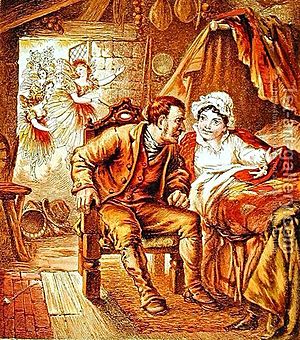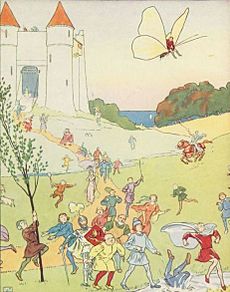Tom Thumb facts for kids
Quick facts for kids Tom Thumb |
|
|---|---|

Frontispiece, 4F
|
|
| Folk tale | |
| Name | Tom Thumb |
| Data | |
| Aarne-Thompson grouping | 700 |
| Country | England |
| Published in | English Fairy Tales The Classic Fairy Tales |
| Related | Hop o' My Thumb Thumbelina Thumbling Thumbling as Journeyman |
Tom Thumb is a very old and famous character from English folklore. His story, The History of Tom Thumb, was first printed in English in 1621. This makes it one of the very first fairy tales published in the English language. Tom is incredibly small, only as big as his father's thumb. His amazing adventures include being swallowed by a cow, facing off against giants, and even becoming a special friend to the legendary King Arthur. People have talked about Tom Thumb for a long time. In the 1500s, he was mentioned in books as a magical being used by maids to playfully scare children. Some even say his home and grave are in Tattershall in Lincolnshire, England.
Tom Thumb isn't just in his own stories. He also appears in a play from 1730 by Henry Fielding, called Tom Thumb. This play was later made even bigger in 1731, becoming The Tragedy of Tragedies, or the History of Tom Thumb the Great.
Around the mid-1700s, books started being made just for children. Some of these books even pretended to be written by "Tommy Thumb." By the mid-1800s, Tom Thumb's story was a must-have in every child's library. His adventures have also been turned into many different movies over the years.
Contents
Tom's Adventures

Richard Johnson's story from 1621 tells us that in the time of King Arthur, there was an old farmer named Thomas. He really wanted a son, even if the boy was no bigger than his thumb. So, he sent his wife to talk to the famous wizard Merlin. Three months later, she gave birth to tiny Tom Thumb! The "Queene of Fayres" (Queen of Fairies) and her helpers were there to welcome him. She gave Tom special clothes: a hat made from an oak leaf, a shirt of cobweb, a jacket of thistledown, stockings of apple peel, and shoes made from mouse skin.
Tom was very clever, but sometimes he used his smarts to cheat when playing games with other boys. Because of his tricks, the other boys didn't want to play with him anymore. Tom got back at them by using magic to hang his mother's pots and glasses from a sunbeam! When the other boys tried to do the same, their pots and glasses fell and broke. After that, Tom stayed home and his mother watched him closely. One Christmas, his mother was making puddings. Tom accidentally fell into the batter and was cooked inside one of them! A tinker (a traveling repairman) came begging, and Tom's mother unknowingly gave him the pudding with Tom inside. The tinker accidentally dropped the pudding, and Tom safely returned home to tell his parents about his wild ride.
After this, his mother kept an even closer eye on him. One day, Tom went with his father to sow seeds in the field. Tom rode inside the horse's ear! His father then set him down in the field to act as a scarecrow. But a raven suddenly swooped down and carried Tom away! His parents searched everywhere for him but couldn't find him.
The raven dropped Tom at the castle of a huge giant. The giant was very cruel and swallowed the tiny boy like a pill. Tom thrashed around so much inside the giant's stomach that the giant vomited him into the sea! There, Tom was eaten again, this time by a fish. This fish was later caught for King Arthur's dinner. The cook was amazed to see the little man pop out of the fish! From that day on, Tom became King Arthur's special Dwarf.
Tom became a favorite at King Arthur's royal court, especially among the ladies. Everyone had fun with him. Tom even joined in the jousting games and danced in the palm of a Maid of Honour. He went home for a short visit to see his parents, taking some money from the king's treasury with permission. Then he returned to court. The Queen of Fairies found him sleeping on a rose and left him some magical gifts: a hat that gave him knowledge, a ring that made him invisible, a belt that let him change his shape, and shoes that could take him anywhere in an instant.
Tom got very sick when a lady blew her nose near him. But he was cured by the doctor of King Twaddell of the Pygmies. He took a ride in his tiny walnut shell coach and met a huge giant named Garagantua. Each of them boasted about their powers. When Garagantua threatened to hurt Tom, Tom used his magic to put a spell on him. Tom then quickly hurried home to safety. King Arthur listened with great surprise to all of Tom's many adventures.
Richard Johnson's story from 1621 ends here. He promised a second part, but it was never found or published. In 1630, a new version of the story was published that continued Tom's adventures.
Later Adventures
Other versions of Tom Thumb's story tell a different ending. One story by Dinah Mulock says that Tom got very tired from jousting but got better in Fairyland. When he came back to King Arthur's court, he accidentally landed in a bowl of the king's porridge. This made the cook very angry, and he threatened to kill Tom! Tom quickly hid in the mouth of a passing miller who had his jaw hanging open. The miller felt tiny voices and movements inside him and thought he was possessed! He yawned, and Tom popped out. But the miller was so mad that he threw Tom into a river, where he was swallowed by a salmon. The fish was caught and taken to the King's kitchen. Tom was found again and kept in a mousetrap until King Arthur forgave him.

Later, the court went hunting, and Tom joined them on his tiny horse, a mouse. A cat caught the mouse, and Tom was hurt. He was taken to Fairyland, where he recovered and lived for several years. When he returned to court, a new king, King Thunston, was ruling. The king was charmed by the little man and gave Tom a tiny coach pulled by six mice. This made the queen jealous because she didn't get such gifts. She then falsely accused Tom of being rude to her. Tom tried to escape on a passing butterfly, but he was caught and put in a mousetrap. A curious cat freed him, and Tom once again won back King Thunston's favor. Sadly, he didn't get to enjoy it for long, as he was killed by a spider's bite. Tom was buried under a rosebush, and a marble monument was built to remember him. His epitaph (words on his grave) read:
- Here lies Tom Thumb, King Arthur’s knight,
- Who died by a spider’s cruel bite.
- He was well known in Arthur’s court,
- Where he afforded gallant sport;
- He rode at tilt and tournament,
- And on a mouse a-hunting went;
- Alive he fill’d the court with mirth
- His death to sorrow soon gave birth.
- Wipe, wipe your eyes, and shake your head
- And cry, ‘Alas! Tom Thumb is dead.
Tom Thumb in Movies and Books
Tom Thumb's story has been made into many films and books.
Animated Shorts
- In 1936, a short cartoon called ComiColor Cartoons, directed by Ub Iwerks, was released.
- In 1940, a Merrie Melodies short called Tom Thumb in Trouble was released by Chuck Jones.
Live-Action Movies
- In 1958, George Pal directed a live-action musical film called tom thumb. The title was written in lowercase to show how small the character is. It starred Russ Tamblyn and was based on the Brothers Grimm's story Thumbling.
- Also in 1958, a Mexican version of Tom Thumb (originally called Pulgarcito) was made. It was loosely based on Charles Perrault's "Le petit Poucet" and wasn't released in the U.S. until 1967.
- In 2001, a French film called Le petit poucet was released. It was directed by Olivier Dahan and starred Nils Hugon, Catherine Deneuve, and Raphaël Fuchs-Willig.
Animated Feature Films
- A darker, more modern stop-motion animated film called The Secret Adventures of Tom Thumb was released in 1993.
- Tom Thumb Meets Thumbelina and the 2002 animated movie, The Adventures of Tom Thumb and Thumbelina, brought together the two most famous tiny people from stories. Tom was voiced by Elijah Wood in the 2002 film.
Literature
- Stories and later comic strips about Tom Thumb appeared in the comic book The Beano from its very first issue in 1938 until the late 1950s.
Similar Tiny Characters Around the World
Tom Thumb is not the only tiny character in stories! Many cultures have their own heroes who are no bigger than a thumb or a finger. Here are some of them:
- Le petit poucet from France
- Der kleine Däumling from Germany
- Little One Inch/Issun-bōshi from Japan
- Thumbikin from Norway
- Garbancito and Pulgarcito from Spain
- Pollicino from Italy
- Piñoncito from Chile
- Липунюшка (Lipunyushka or No-Bigger-Than-A-Finger) from Russia
- Palčić from Serbia
- Patufet from Catalonia
- The Hazel-nut Child from Bukovina
- Klein Duimpje and Pinkeltje from the Netherlands
- Hüvelyk Matyi from Hungary
- Ko Ko Nga Latt Ma from Myanmar
- দেড় আঙ্গুলে (Dēṛa āṅgulē) from Bengal
- Sprīdītis from Latvia
See also
 In Spanish: Pulgarcito (cuento de hadas) para niños
In Spanish: Pulgarcito (cuento de hadas) para niños

